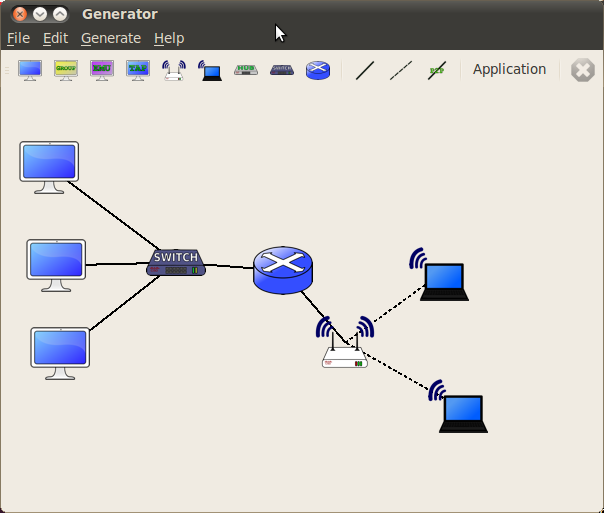Topology Generator: Difference between revisions
| Line 33: | Line 33: | ||
[[File:Ns-3-generator-test.png]] | [[File:Ns-3-generator-test.png]] | ||
C++ code generated from the above screenshot. | [[File:Ns-3-generator-test.cc.patch]]: C++ code generated from the above screenshot. Python code can also be generated. The configuration can be saved in XML and reloaded. '''Note:''' two applications were added and can be sen in the generated code (not visible in the screenshot). | ||
== Feature requests == | == Feature requests == | ||
Revision as of 16:59, 19 May 2010
Main Page - Roadmap - Summer Projects - Project Ideas - Developer FAQ - Tools - Related Projects
HOWTOs - Installation - Troubleshooting - User FAQ - Samples - Models - Education - Contributed Code - Papers
The ns-3 topology generator project aims to provide a quick and easy way to create ns-3 topology. It provides intuitive GUI so you can add nodes, link, applications, ... and generates C++ simulation code for ns-3.
This tool has been written by Pierre Weiss and Sebastien Vincent, University of Strasbourg.
Prerequisites
You need Qt 4 libraries to compile and use ns-3 topology generator.
Installation
To build the project:
$ qmake $ make
Usage
To use it, simply run:
$ ./ns-3-generator
To generate the API documentation (you need doxygen tool): $ doxygen Doxyfile
The HTML generated documentation is located in doc/html/ directory of sources.
Configurations may be saved to an XML file and later loaded.
Example screenshot
File:Ns-3-generator-test.cc.patch: C++ code generated from the above screenshot. Python code can also be generated. The configuration can be saved in XML and reloaded. Note: two applications were added and can be sen in the generated code (not visible in the screenshot).
Feature requests
- Ability to configure tracing
- (others go here)
